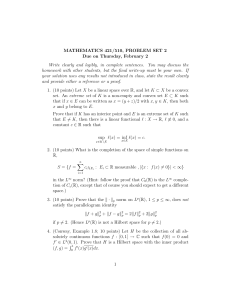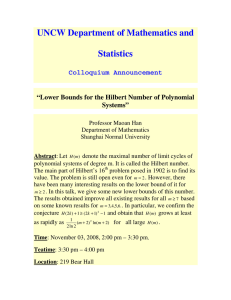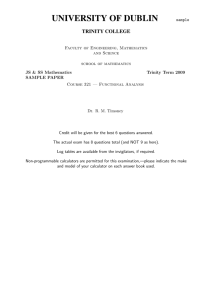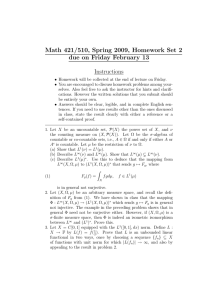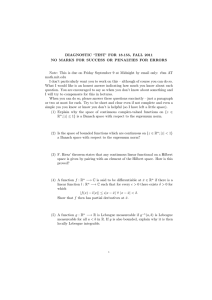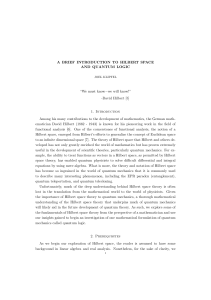5. Hilbert space We have shown that L
advertisement
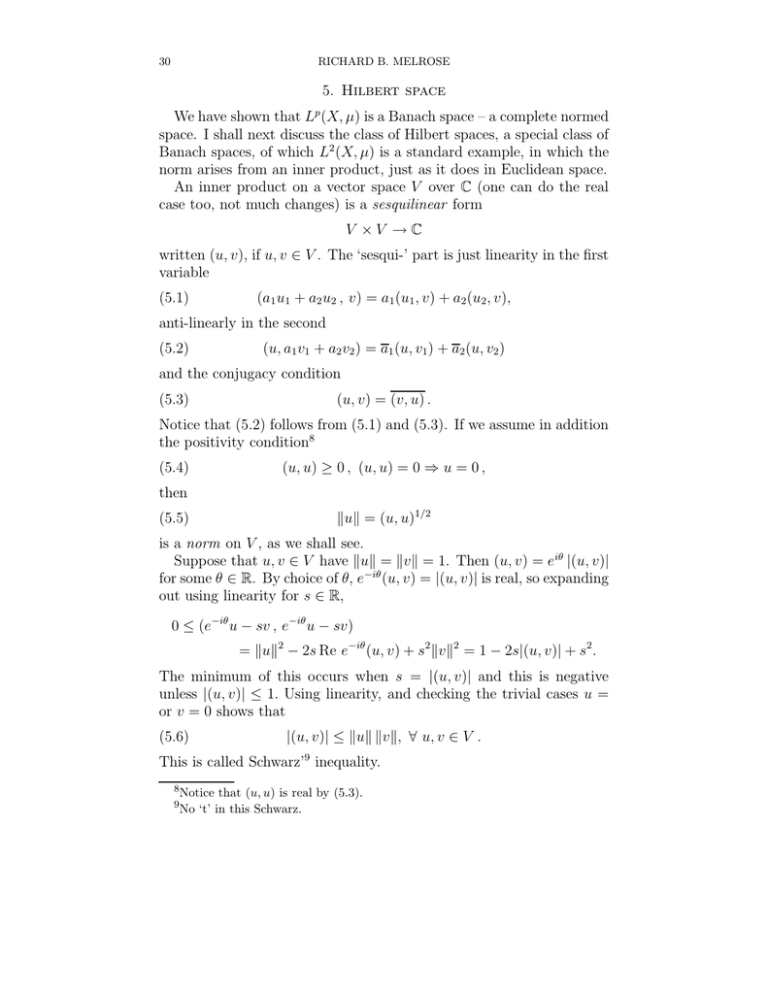
30
RICHARD B. MELROSE
5. Hilbert space
We have shown that Lp (X, µ) is a Banach space – a complete normed
space. I shall next discuss the class of Hilbert spaces, a special class of
Banach spaces, of which L2 (X, µ) is a standard example, in which the
norm arises from an inner product, just as it does in Euclidean space.
An inner product on a vector space V over C (one can do the real
case too, not much changes) is a sesquilinear form
V ×V �C
written (u, v), if u, v ⊂ V . The ‘sesqui-’ part is just linearity in the first
variable
(5.1)
(a1 u1 + a2 u2 , v) = a1 (u1 , v) + a2 (u2 , v),
anti-linearly in the second
(5.2)
(u, a1 v1 + a2 v2 ) = a1 (u, v1 ) + a2 (u, v2 )
and the conjugacy condition
(5.3)
(u, v) = (v, u) .
Notice that (5.2) follows from (5.1) and (5.3). If we assume in addition
the positivity condition8
(5.4)
(u, u) → 0 , (u, u) = 0 ≤ u = 0 ,
then
⇒u⇒ = (u, u)1/2
(5.5)
is a norm on V , as we shall see.
Suppose that u, v ⊂ V have ⇒u⇒ = ⇒v⇒ = 1. Then (u, v) = ei� |(u, v)|
for some � ⊂ R. By choice of �, e−i� (u, v) = |(u, v)| is real, so expanding
out using linearity for s ⊂ R,
0 ∀ (e−i� u − sv , e−i� u − sv)
= ⇒u⇒2 − 2s Re e−i� (u, v) + s2 ⇒v⇒2 = 1 − 2s|(u, v)| + s2 .
The minimum of this occurs when s = |(u, v)| and this is negative
unless |(u, v)| ∀ 1. Using linearity, and checking the trivial cases u =
or v = 0 shows that
(5.6)
|(u, v)| ∀ ⇒u⇒ ⇒v⇒, � u, v ⊂ V .
This is called Schwarz’9 inequality.
8Notice
9No
that (u, u) is real by (5.3).
‘t’ in this Schwarz.
LECTURE NOTES FOR 18.155, FALL 2004
31
Using Schwarz’ inequality
⇒u + v⇒2 = ⇒u⇒2 + (u, v) + (v, u) + ⇒v⇒2
∀ (⇒u⇒ + ⇒v⇒)2
=≤ ⇒u + v⇒ ∀ ⇒u⇒ + ⇒v⇒ � u, v ⊂ V
which is the triangle inequality.
Definition 5.1. A Hilbert space is a vector space V with an inner
product satisfying (5.1) - (5.4) which is complete as a normed space
(i.e., is a Banach space).
Thus we have already shown L2 (X, µ) to be a Hilbert space for any
positive measure µ. The inner product is
�
(5.7)
(f, g) =
f g dµ ,
X
since then (5.3) gives ⇒f ⇒2 .
Another important identity valid in any inner product spaces is the
parallelogram law:
(5.8)
⇒u + v⇒2 + ⇒u − v⇒2 = 2⇒u⇒2 + 2⇒v⇒2 .
This can be used to prove the basic ‘existence theorem’ in Hilbert space
theory.
Lemma 5.2. Let C � H, in a Hilbert space, be closed and convex (i.e.,
su + (1 − s)v ⊂ C if u, v ⊂ C and 0 < s < 1). Then C contains a
unique element of smallest norm.
Proof. We can certainly choose a sequence un ⊂ C such that
⇒un ⇒ � � = inf {⇒v⇒ ; v ⊂ C} .
By the parallelogram law,
⇒un − um ⇒2 = 2⇒un ⇒2 + 2⇒um ⇒2 − ⇒un + um ⇒2
∀ 2(⇒un ⇒2 + ⇒um ⇒2 ) − 4� 2
where we use the fact that (un + um )/2 ⊂ C so must have norm at least
�. Thus {un } is a Cauchy sequence, hence convergent by the assumed
completeness of H. Thus lim un = u ⊂ C (since it is assumed closed)
and by the triangle inequality
|⇒un ⇒ − ⇒u⇒| ∀ ⇒un − u⇒ � 0
So ⇒u⇒ = �. Uniqueness of u follows again from the parallelogram law
which shows that if ⇒u� ⇒ = � then
⇒u − u� ⇒ ∀ 2� 2 − 4⇒(u + u� )/2⇒2 ∀ 0 .
32
RICHARD B. MELROSE
�
The fundamental fact about a Hilbert space is that each element
v ⊂ H defines a continuous linear functional by
H � u ∈−� (u, v) ⊂ C
and conversely every continuous linear functional arises this way. This
is also called the Riesz representation theorem.
Proposition 5.3. If L : H � C is a continuous linear functional on
a Hilbert space then this is a unique element v ⊂ H such that
(5.9)
Lu = (u, v) � u ⊂ H ,
Proof. Consider the linear space
M = {u ⊂ H ; Lu = 0}
the null space of L, a continuous linear functional on H. By the as­
sumed continuity, M is closed. We can suppose that L is not identically
zero (since then v = 0 in (5.9)). Thus there exists w ⊂
/ M . Consider
w + M = {v ⊂ H ; v = w + u , u ⊂ M } .
This is a closed convex subset of H. Applying Lemma 5.2 it has a
unique smallest element, v ⊂ w + M . Since v minimizes the norm on
w + M,
⇒v + su⇒2 = ⇒v⇒2 + 2 Re(su, v) + ⇒s⇒2 ⇒u⇒2
is stationary at s = 0. Thus Re(u, v) = 0 � u ⊂ M , and the same
argument with s replaced by is shows that (v, u) = 0 � u ⊂ M .
Now v ⊂ w + M , so Lv = Lw =
≥ 0. Consider the element w � =
w/Lw ⊂ H. Since Lw � = 1, for any u ⊂ H
L(u − (Lu)w � ) = Lu − Lu = 0 .
It follows that u − (Lu)w � ⊂ M so if w �� = w � /⇒w � ⇒2
(u, w �� ) = ((Lu)w � , w �� ) = Lu
(w � , w � )
= Lu .
⇒w � ⇒2
The uniqueness of v follows from the positivity of the norm.
�
Corollary 5.4. For any positive measure µ, any continuous linear
functional
L : L2 (X, µ) � C
is of the form
�
f g dµ , g ⊂ L2 (X, µ) .
Lf =
X
LECTURE NOTES FOR 18.155, FALL 2004
33
Notice the apparent power of ‘abstract reasoning’ here! Although we
seem to have constructed g out of nowhere, its existence follows from
the completeness of L2 (X, µ), but it is very convenient to express the
argument abstractly for a general Hilbert space.

